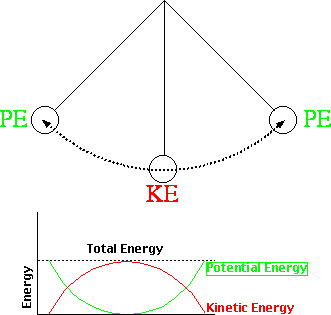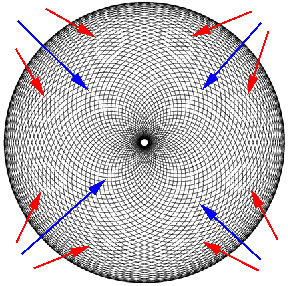See Prior Pages on Harmonic Patterns: Page 1, Page 2, Page 3, Page 4
There is a class of stars that could be described as having variable magnitude. They have a time varying light output.
The Ball-of-Light Particle Model predicts the cores of such stars are very large elementary particles that are pulsating in a variable manner between the 3 fundamental forces: electric, magnetic, and gravitational.

In the classic example of a swinging pendulum, the total energy of the system can be described by adding the Potential Energy of the mass and the Kinetic Energy of the Mass. The energy oscillates between potential energy and kinetic energy -- but the total excluding minor losses remains the same.
In this animation of a pulsating ball-of-light, the electric field is represented by magenta, the magnetic field is represented by blue, and the gravitational field is not represented because the green arrows that would represent the field would be inside the sphere pointing inwards.
Once again, the energy pulsates between potential energy and kinetic energy. As the sphere pulses out, the outer electromagnetic fields pull away from the center of the sphere and the potential energy becomes primarily gravitational. As the the sphere pulses in, compressing the electromagnetic fields the potential energy becomes primarily electromagnetic. In between, as the sphere is changing size, the kinetic energy is the greatest.
Note, a seemingly perplexing feature of Cepheid Variables is exactly explained by this explanation. The electromagnetic patches would most likely induce smaller balls-of-light off of the central sphere as the sphere is expanding at its greatest rate. This is when the pulsating star would be brightest. Traditional theory would have the star the brightest when it was greatest is size or when it was hottest (smallest size) -- not when it is changing size at the greatest rate.
One wave turning counter clockwise
One wave turning clockwise
If these two waves are combined, then the resulting pulsating wave would have roughly zero angular momentum.
It would also be possible for the upper half and the bottom half of each wave to be spinning in opposite directions instead of in the same direction as depicted above. (Alas, that difficult animation is for another day!)
An even more realistic animation would use a patch pattern that had better spacing such as in the image below.
Finally, let me point out that the spherical pattern might have regularly space nodes on the overall pattern, such as depicted in the image below.

Nodes like these can be seen on the surface of the sun.
If you have a Hoberman Sphere (TM), then you can demonstrate this theory to friends and relatives as shown in the following animation. The holes in the sphere could be thought of as representing alternating patches of electric and magnetic fields.